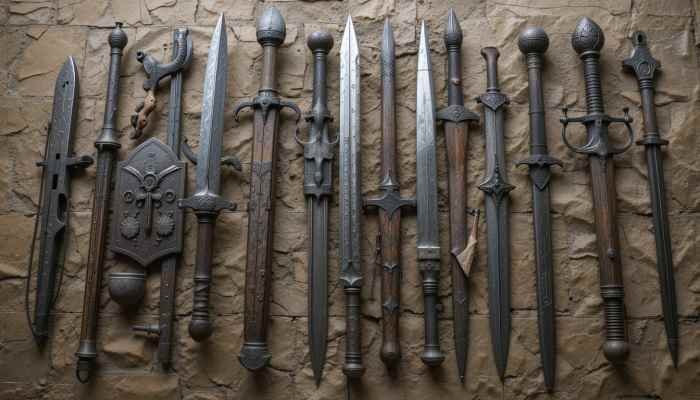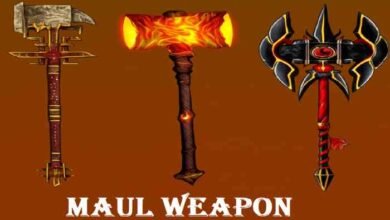Medieval Weapons: History, Types & Lasting Influence

Medieval weapons incontestably shaped the state of war, the state of politics and the state of society from the 5th through the 15th century. The processes that generated them revealed the advancements of technological thinking, regional needs, and religious interests of the period. From family types of sword makers to absurd weapons from genuine necessity, medieval weapons give us a nerdy glimpse into worlds gone by.
This article will cover the kinds of guns and where they came from, as well as the epic uses and legacies of medieval weapons, to which I can also add the wildest modern-day interests of sale, game mods, and LEGO builds!
- Introduction: The Power and Purpose of Medieval Weapons
- Types of Medieval Weapons
- Medieval Weapons and Armor: A Symbiotic Relationship
- Best Medieval Weapons of the Battlefield
- Unique Medieval Weapons That Stood Out
- Strange and Weird Medieval Weapons
- Medieval Weapons Flail: Myth or Reality?
- German Medieval Weapons: Practically and Brutally Made
- Fantasy Medieval Weapons: Realism and Imagination
- Medieval Weapons Mod: Reviving Ancient Tools in Digital Worlds
- Medieval Weapons for Sale: Collecting and Reenactment
- LEGO Medieval Weapons: Building the Past, Brick by Brick
- Medieval Weapons List: A Glimpse at the Arsenal
- The Evolution of Medieval Weapons Through Time
- Conclusion: Why Do Medieval Weapons Retain Our Fascination?
Introduction: The Power and Purpose of Medieval Weapons
Weapons of the medieval ages were understood as more than instruments of war. They were outward expressions of power, rank, and personal honour. Knights took heraldic arms to the battlefield with the knight heraldic arms emblazoned on their shields and their swords. Peasants took the tools of the field to the battlefield to obtain weapons.
Those who were tasked with developing siege technology to build castles and defend them, and with each successive war, there were designs of weapon categories and variations, some useful and some absurd. To understand medieval weapons is to understand how warfare evolved and the radical diffusion of those simple tools that still capture the present imagination.
Types of Medieval Weapons
The variety of weapons used during the Middle Ages can be grouped into several main categories based on function:
1. Melee Weapons
These include close-combat tools like:
- Swords – such as longswords, arming swords, and falchions.
- Axes – like the Danish axe or bearded axe.
- Maces and Morningstars – blunt-force weapons used to crush armor.
- Daggers – small and often used as a last resort.
2. Polearms
These long-reach weapons were especially effective against cavalry and armored foes:
- Spears
- Halberds
- Glaives
3. Projectile Weapons
Ideal for ranged attacks, these included:
- Longbows – key to English military supremacy in the Hundred Years’ War.
- Crossbows – powerful, easier to learn, but slower to reload.
- Slings and Throwing Axes
4. Siege Weapons
Used to breach castles and fortresses:
- Trebuchets
- Ballistae
- Battering Rams
Medieval Weapons and Armor: A Symbiotic Relationship

The progression of weapons went hand-in-hand with that of armour. With chains transitioning into plate armour, swords became thinner and flared in shape; flails became more accepted as the shield could be evaded, and war hammers were designed to transfer the blunt force through metal. This was an unending cycle of evolution; new armour caused new weapons, and vice versa. One example of this evolution is the poleaxe, created for the armoured knight.
Best Medieval Weapons of the Battlefield
While all medieval weapons served specific purposes, some stood out for their effectiveness:
- The Longbow: Capable of piercing armor at 200+ yards, famously used by English archers.
- The War Hammer: Devastating against plate armor due to its blunt-force design.
- The Arming Sword: The knight’s standard weapon—versatile, balanced, and iconic.
- Halberd: Effective against both cavalry and infantry, it was a staple of Swiss and German armies.
These weapons weren’t just deadly—they were highly efficient tools in the chaos of medieval battlefields.
Unique Medieval Weapons That Stood Out
History is filled with uniquely crafted weapons that reflected ingenuity:
- Urumi: A flexible whip-sword from South Asia, dangerous even to its wielder.
- Gun Shields: Early experiments in combining firearms with defense.
- Swordbreaker: A dagger designed to catch and snap enemy blades.
These oddities show how diverse medieval weapon designs could be, ranging from the practical to the downright experimental.
Strange and Weird Medieval Weapons
In times of war, desperation breeds creativity. Here are some strange medieval weapons that defy logic:
- Man Catcher: A pole weapon with prongs used to capture enemies alive.
- Holy Water Sprinkler: A spiked mace with a church-inspired name.
- Scissor Sword: A dual-bladed sword that could clamp and trap enemy weapons.
Such weapons may seem impractical today, but they were taken seriously in their time and often reflected cultural and regional needs.
Also Read: DnD Weapons: Guide Blades, Bludgeons & Battle Tactics
Medieval Weapons Flail: Myth or Reality?
The flail—a type of weapon with a spiked ball on the end connected with a chain—has attained iconic status from medieval imagery, But historians disagree on the actual use of the flail. Some historians or opinions say it was likely used only ceremonially or symbolically. However, evidence suggests that there are variants that were used as a legitimate weapon on the battlefield. It is difficult to resist this enhanced weaponry, weaponizing that circumvented shields and helmets, and it creates an unpredictable strike.
German Medieval Weapons: Practically and Brutally Made

Among all medieval weaponry created, some of the most advanced weapon designs were made in Germany. The zweihänder was a large two-handed sword used by landsknechts to break up pike formations. Dutch inventions included war hammers, stone and flanged maces, and early arquebuses. Their innovations and durability could also be attributed to German metallurgists.
Fantasy Medieval Weapons: Realism and Imagination
Inspired by realism, medieval weapons became the origin of innumerable fantasy weapons. To sum up, in simple words, you can have a glowing sword or a spear that slays dragons. Fantasy medieval arms arise as a borrowing from historical concepts, hand in hand between reality and imagination, in acts of mysticism. The fantasy structure of medieval arms for entertainment and storytelling has instead formed through fandoms like The Lord of the Rings, Game of Thrones, and video games like Skyrim or Dark Souls, occasionally rediscovering in popular culture.
Medieval Weapons Mod: Reviving Ancient Tools in Digital Worlds
Thanks to game modification communities, medieval weapons now thrive in virtual form. Mods for games like Minecraft, Skyrim, and Mount & Blade allow players to craft, wield, and battle with historically accurate or fantastical medieval weaponry. These mods often feature:
- Detailed 3D models of swords, flails, and halberds
- Realistic physics for chain weapons
- Weapon progression trees and armor counters
Such tools not only entertain but educate players about medieval warfare dynamics.
Medieval Weapons for Sale: Collecting and Reenactment
Interest in medieval weapons isn’t limited to museums. Today, you can find:
- Replica Swords and Daggers – for collectors and display
- Battle-Ready Weapons – forged for use in reenactments or HEMA (Historical European Martial Arts)
- Armor Sets and Shields
Websites and specialty stores cater to collectors, historians, and enthusiasts. Many items are handmade using traditional techniques, often accompanied by certificates of authenticity.
LEGO Medieval Weapons: Building the Past, Brick by Brick
LEGO’s medieval sets successfully transport people to the age of wonder, magic, and drama. These mini swords, axes, and catapults are used around the world by children and collectors alike, resulting in even castle-themed series based on armoured knights, fantasy characters, and siege machines that help capture both the interest of children and engage them to have an interest in medieval history.
Medieval Weapons List: A Glimpse at the Arsenal
Here’s a consolidated, common and unique medieval weapons list:

- Swords: Arming sword, longsword, falchion
- Axes: Battle axe, bearded axe
- Maces and Hammers: Morningstar, war hammer, flanged mace
- Polearms: Spear, halberd, glaive
- Bows: Longbow, shortbow, crossbow
- Flails: One-handed and two-handed variants
- Daggers: Rondel, bollock dagger
- Throwing Weapons: Javelin, throwing axe
- Siege Engines: Trebuchet, mangonel, battering ram
Each of these had a distinct function depending on the battlefield scenario and enemy armor.
The Evolution of Medieval Weapons Through Time
For centuries before that, these medieval arsenals witnessed the struggles of warfare and contests of geopolitics and technology. Weapons were first simple clubs or spears; they then assumed the character of swords and polearms before proceeding to sophisticated siege-engineering devices. However, although gunpowder has swept aside most forms of traditional medieval weaponry, medieval weapons will remain enshrined in military discourse and popular culture.
Conclusion: Why Do Medieval Weapons Retain Our Fascination?
The medieval weapon was an art set to war; technology was at its peak; finally, it represented cultural identity. Its design embodied the tales of peoples who wielded it, wars it fought, and societies it forayed into to protect or oppress. Medieval weapons continue to symbolize cultural identity through historical scholarship and recreation (fantasy literature and LEGO sets). We still appreciate their beauty and fear the deadly designs that still captivate many generations’ minds.




